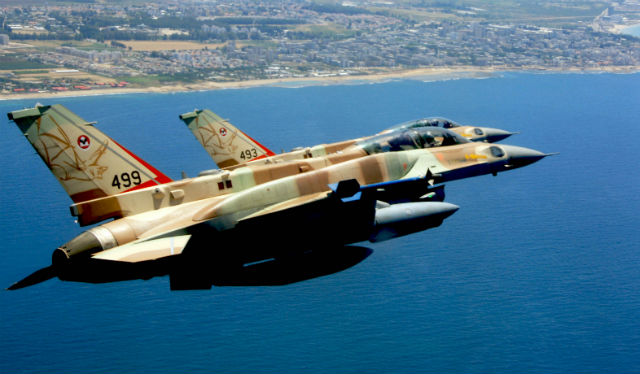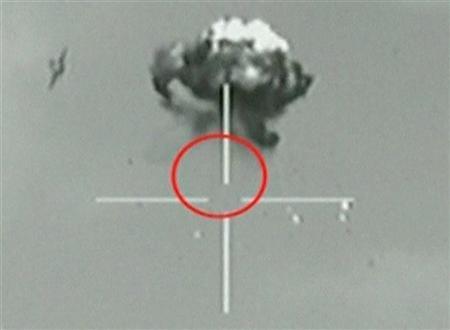 An Israeli Air Force Lockheed Martin F-16 has shot down an unmanned aircraft launched from Lebanon by Hezbollah militants. The threat was detected over the Mediterranean sea on 25 April and was destroyed shortly after by an air-to-air missile.
An Israeli Air Force Lockheed Martin F-16 has shot down an unmanned aircraft launched from Lebanon by Hezbollah militants. The threat was detected over the Mediterranean sea on 25 April and was destroyed shortly after by an air-to-air missile.
The encounter occurred at 13:30 local time, and an air force helicopter transporting Israeli prime minister Benjamin Netanyahu for an official visit to the north of the country landed as fighters were scrambled.
 The interception was made not far from the coastal border between Israel and Lebanon. There is no evidence to suggest the UAS was armed or that it was aimed at an Israeli offshore pumping rig which has recently started to extract natural gas from the Tamar under-sea reservoir. The Israeli Air Force is operating special systems to protect this potential target for terror organisations.
The interception was made not far from the coastal border between Israel and Lebanon. There is no evidence to suggest the UAS was armed or that it was aimed at an Israeli offshore pumping rig which has recently started to extract natural gas from the Tamar under-sea reservoir. The Israeli Air Force is operating special systems to protect this potential target for terror organisations.
“The Israeli military command doesn’t treat UAS launched from Lebanon lightly, since their goal may be not only taking pictures, but also an assassination of senior officials, military or political,” an unnamed Western diplomat is quoted in Nahar newspaper.
The Israeli Prime Minister was flying across northern Israel when the UAS was spotted above the sea on Thursday, 10 km west of the port city Haifa. Mr Netanyahu’s helicopter was forced to land and was grounded until the Israeli Air Force had secured Israeli air space.
Initial media reports presumed the UAS had been launched by Hezbollah. In October last year, the Lebanese militant group has claimed as a great victory their successful piloting of an unmanned aircraft in the skies above the Israeli Negev for more than half an hour before it was downed, several miles from Israel’s Soreq nuclear facility. In fact, the Israeli military had stated only that an unmanned aircraft had been launched “from Lebanon”.
Iran’s involvement in this cross-border incident, and Washington’s pleas for restraint, may explain Benjamin Netanyahu’s failure to threaten retaliation for the incursion. The Israeli Prime Minister said only that he has taken “the attempt to breach our borders very seriously”.
According to Syrian rebels and Israeli intelligence, Tehran has poured Revolutionary Guard soldiers into Syria and Lebanon to support its Shiite allies. The Iranian fighters, thought to include several senior commanders, have been tasked with arming and training Syrian soldiers in sophisticated weaponry, such as short and long range missiles, and upgrading Hizbollah’s UAS capabilities. Arab media outlets have reported that Iran transfers five tonnes of weaponry into Syria every week.
Israel’s latest interception of a UAS is the fifth such action to have been performed by its air force in the past decade.
Most recently, in October 2012, a UAS was destroyed over Israeli territory, after being flown from Lebanon and over the Gaza Strip. In November 2011, an unmanned aircraft – later identified as a Seeker – was also shot down by an Israeli F-16, having been launched from Lebanon. An Iranian-made Ababil UAS that was being operated by Hezbollah during fighting on the Israeli/Lebanese border was also destroyed by an F-16 in 2006, with its debris falling into the Mediterranean.
Since a similar occurrence in November 2004, the air force has fielded additional sensors that have improved its capability to detect unmanned systems trying to enter Israeli airspace.
Photo: F-16 – Israeli Air Force
Sources: Flight Global; The Telegraph
